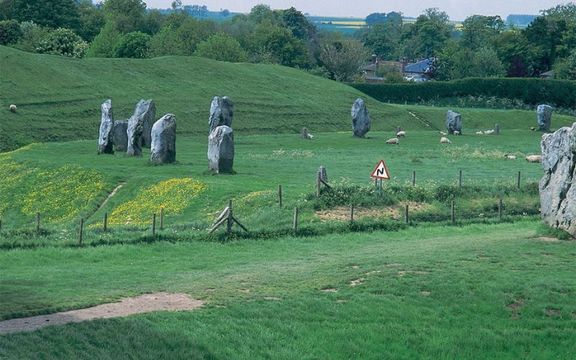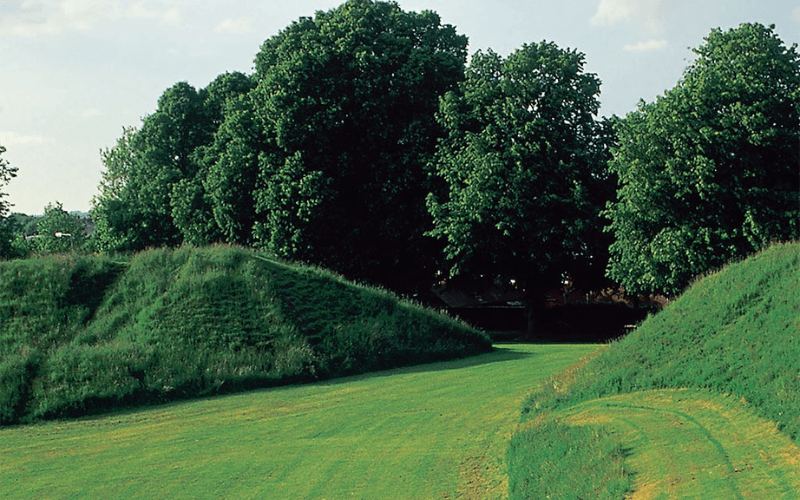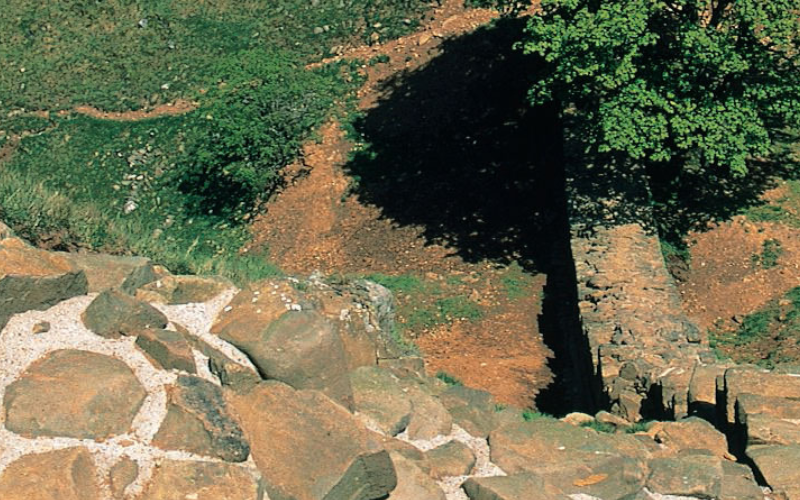
England’s Un-natural LandscapeJim Hargan
Throughout ancient Britain, the hand of man is almost as ubiquitous as the hand of God.
The Ridgeway is Britain’s oldest road, an 85-mile-long National Trail from Wiltshire to the Chilterns that follows the ancient chalk ridge used as a highway in prehistory.[/caption]
When Americans discuss the environment, they tend to talk about natural/clean/good ecosystems vs. manmade/polluted/bad ones. When they talk about “restoring” the environment, they are talking about returning a human-influenced landscape to its natural state. This is so normal in America that people have a hard time thinking in any other terms.
So it can be quite a shock to discover that England (along with Wales and nearly all of Scotland) has no natural landscape at all, has not had one for many centuries, and maybe even never had one. In England, “good” and “bad” environments are a choice between competing human-made landscapes—just the sort of thing many Americans consider too dicey for government intervention. Of course, the British government does intervene, and quite a lot. The landscape politics that result can be quite lively.
Take that eternal symbol of the English countryside, the hedgerow. Until about 80 years ago, those dense, carefully managed field hedges were the preferred method of keeping livestock away from crops and roads. Every 20 or 25 years, the farmer would have to trim and thicken his hedges by cutting the largest branches nearly clean through, laying them over, and intertwining them. Nowadays, however, wire fences are cheaper, and ancient hedgerows get in the way of mechanized farm equipment. Farmers have been grubbing up their hedgerows for decades, and British environmentalists have been fighting the destruction for just as long.
Of course, in the usual American terms this isn’t an environmental issue at all. It’s just a choice between two different types of fences, one pretty and expensive, the other cheap and ugly. English environmentalists make a biodiversity case, in addition to the pretty vs. ugly case: The completely man-made hedgerow creates niches for more plants and animals than the equally artificial wire fences, although few of the hedgerow-hugging species are rare and some (from the farmer’s view) are pests.
Farmers make the case that the 18th-century farming methods that caused this artificial biodiversity, in fact, have not been able to produce profitable crops since the 1890s. Your preference depends on what you want to do with the field—gaze at it or sell its wheat. As you might expect, the government comes down solidly on both sides of the issue, at once subsidizing hedgerow removal and issuing a paper blizzard of regulations to hinder it.
The fact is, England lost its natural landscape quite a long time ago.
Archaeological pollen analysis shows that the Romans chopped down the last of the native English forests in the 2nd century AD. By AD 350, only 3 percent of modern England was forested, and that was all in the form of woodlots, carefully managed for the farmers’ needs. Well, what about that Great Wood that King Arthur’s knights were pricking through with such abandon? The Great Wood existed all right. It grew up during the Dark Ages on abandoned Roman villas, whose woodlots supplied all the seeds. In other words, the Great Wood’s tree species were chosen by Romano-Celtic farmers—human selection as much as natural selection.

Even the pre-Roman forests might have been human-selected rather than natural. After all, England was covered by glaciers as far south as the Thames Valley as late as 12000 BC. Advanced Stone Age cultures entered England as fast as the glaciers melted, and these cultures had the technology to induce large-scale changes in the postglacial ecology faster than it could stabilize. Pollen evidence indicates that these methods existed just about everywhere. If you could visit Neolithic England, you might find it as heavily farmed as modern-day England—particularly around central Wiltshire, where Avebury and Stonehenge were centers of a sophisticated farm-based society. Neolithic settlers even had commercial mines (for high-quality flint), one of which survives in Norfolk as Grime’s Graves and is still linked to Avebury and Stonehenge by the Stone Age highway known as the Ridgeway.
The most famous “natural” areas have similarly human-induced beginnings. The Fens are the most natural of the bunch; they came into existence during the post-Roman sea-level rises that created Holland’s Zuider Zee. Most rises only lasted a few hundred years, and Dutch engineers pumped out the last of them in the 1600s. The nearby Broads, however, are as unnatural as it gets; they are flooded peat cuttings that were created in the 12th century as a fuel source.
South England’s grass-covered downlands were forested before Stone Age farmers burnt off the trees to improve the grazing. Bronze Age farmers converted a high Devonshire forest into farms—and these farms deteriorated into the peat bogs now called Dartmoor, a piece of environmental destruction that has lasted for 3,000 years with no end in sight.
Similarly, early agricultural practices formed the wild-looking cores of many of Britain’s great national parks: Exmoor, Snowdonia, the Lakes, the Yorkshire Moors, the Yorkshire Dales and the Peaks among them. Even the Scottish Highlands used to be forested. Nowadays, you count Scotland’s surviving Caledonian forests in the dozens of acres—and that’s about it for Great Britain’s natural ecosystems.
Without natural ecosystems to fight over, the battles were waged over unnatural ones. The struggles go back 1,000 years, with William the Conqueror starting forest regulation in the 1070s. Just like today’s controversies, the Conqueror’s Forest Initiative was highly contentious and extremely political, and there was an agenda hidden in it.
Back then, the word “forest” did not mean a tree-based ecosystem; that is a modern usage. In medieval times, a forest was a royal hunting reserve and contained a great deal of farmland and upland grazing as well as forests in the modern sense. Hunting was important to the royal household, and not just for sport; royal hunting parties harvested games as an important part of the royal food budget. William the Conqueror’s goal was to systematically manage the game to maximize both numbers and diversity. His methods were similar to a modern wildlife refuge—preserving environments, increasing environmental diversity, improving game food sources, and restricting hunting.
Read more
William had a problem, however, with the traditional land ownership system. In feudal Europe, nobles held land on behalf of the king, while commoners and nobles had a baffling muddle of interlocking obligations and privileges. Doth the king wish to preserve the acorns for the wildlife’s winter forage? Alas, good king, the local villagers possess the right, granted unto them by laws most ancient, to turn their pigs out into the oak forests, consuming all the “mast” (as the acorn crop was called) and starving out the game. So William invented the policy of confiscating estates from disloyal Saxon earls (always in plentiful supply), and converting those estates to royal forests. As both owner and king, William could void the welter of traditional rights and impose his wildlife management regulations.
And, yes, William had an ulterior motive. When Duke William of Normandy shook loose England’s crown, he repeatedly emphasized that his claim was legal and proper according to existing English law, and that the man he conquered was a usurper rather than the rightful king. Later, William found himself bound by that law, which put all sorts of restrictions on him that he didn’t much like. Not only did he have to govern with the consent of his earls (not so big a problem, as he packed his earldom with family and retainers every chance he got), he also had to give all sorts of aristocrats and officials a cut of the royal cash flow. Forests solved the latter problem. By governing the forests directly, he cut out the noble middlemen who would ordinarily be skimming most of the proceeds. Instead of trusting expensive and untrustworthy nobles to rule those forests, William hired a phalanx of professional bureaucrats—reeves and foresters—who might be well-paid by commoner standards but were decidedly cheap compared to nobles.
alas, good king, the local villagers possess the right, granted unto them by laws most ancient, to turn their pigs out into the oak forest. ‘natural’ includes historical, cultural, archaeological, vernacular and even architectural features.
Later kings discovered an even more important revenue stream: a complex system of steep fines with draconian enforcement. Within a century, the Forest Law had evolved into the medieval version of a speed trap, with reeves and foresters trolling for unwary violators who could be milked for fines. No issue more united landowners and merchants against the king; fully half the Magna Carta is devoted to bringing those royal environmental laws under control.
Fast forward to the modern era. Forest Law, ensconced in the Magna Carta, provides a regulatory framework for land use that would make an American bureaucrat drool. And remember the feudal system’s interlocking land rights and obligations? Well, that continued to grow for hundreds of years after William, and a surprising amount of it continues today—from masting your pigs in the local woods, to taking firewood from the commons, to walking across your neighbors’ fields. With both forests and feudalism long gone, those two conflicting traditions can take some surprising shapes.
Take the limited right to walk across your neighbor’s fields, along traditionally set rights of way. In the medieval field system, this was a necessary part of farming, as a single farmer might have two dozen small tracts scattered about his village in all directions. By the 19th century, this rationale no longer existed, but the rights of way continued anyway—and people began walking along them for sport and exercise. Rural folk reacted in ways ambiguous and contradictory, at once liking the shortcuts and disliking the trespassers. Conan Doyle made fun of those attitudes in The Hound of the Baskervilles, as when Dr. Watson describes Mr. Frankland of Lafter Hall: “Sometimes he will shut up a right of way and defy the parish to make him open it. At others he will with his own hands tear down some other man’s gate and declare that a path has existed there from time immemorial, defying the owner to prosecute him for trespass.”

Jim Hargan
Things came to a head in 1932, when more than 400 hikers in Derbyshire’s Peak District fought with gamekeepers trying to keep them off Kinder Scout, a prominent peak. The “Kinder Scout Mass Trespass” led to reforms that mapped and marked 118,000 miles of rural rights of way, and (in 2000) created a “right to roam” in traditionally open areas.
The most remarkable result of all those reforms, however, is Britain’s distinctive national park system. Since 1951 Parliament has created 15 of these parks, including three in Wales and two in Scotland; when you include the similarly organized Areas of Outstanding Natural Beauty (AONBs), fully 24 percent of England is within one of these special districts. Needless to say, the government does not own all this land. In fact, it owns nearly none of it. National parks and AONBs are the modern equivalent of medieval forests, without the corruption and fee gouging. They are management districts with special, and highly restrictive, regulations—those favoring thatched roots and hedgerows.
British national parks, unlike the ones in America, concentrate on aesthetics over the environment. Under the 1949 enabling act, national parks exist first and foremost to preserve “natural beauty,” with recreation a distant second. Conservation, wilderness preservation, wildlife, biodiversity—these didn’t even rate a mention, although a 1995 act did belatedly add wildlife conservation to the natural beauty standard. And, as you might expect, British natural beauty isn’t all that natural; a 1968 act said that “natural” included historical, cultural, archaeological, vernacular and even architectural features. Lest you think this is all old-style thinking, an act passed in 2000 reiterated the natural beauty standard yet again.
How strict are the regulations in those areas? In the North Wessex AONB, I once talked with a cottage owner, Mrs. Marion Warren. I admired her beautiful cottage with its thatched roof, built in the 1820s as servants’ quarters for the nearby manor house, but I wondered at the bright yellow front door. Was that a traditional color? “No,” she told me. “That was the color it was painted when the house was inventoried as historic in 1949. They haven’t let us change the color since.”
That’s landscape politics, British style.
* Originally published in 2018. Updated in 2022.





Comments